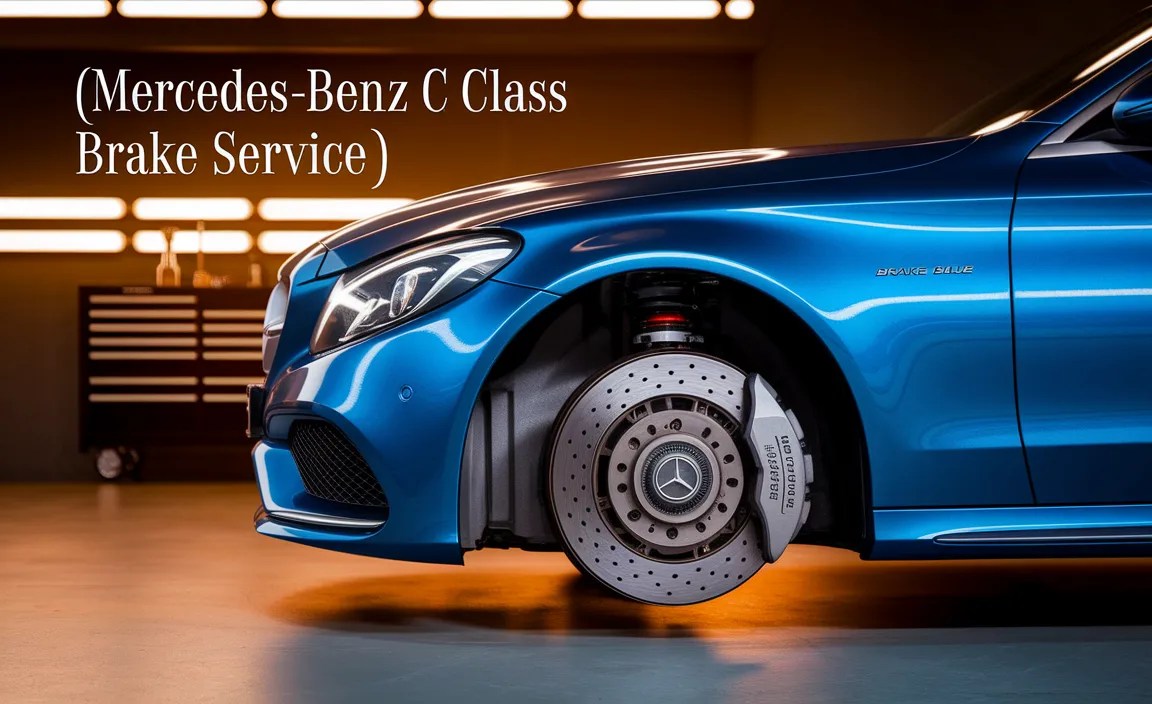Mercedes-Benz C Class Brake Service: Ultimate Performance
Your C-Class needs expertly maintained brakes for optimal performance and safety. A thorough brake service ensures responsiveness, prevents costly damage, and delivers the confident stopping power expected from a Mercedes-Benz. Keep your luxury sedan performing at its peak with this guide.
Driving a Mercedes-Benz C-Class is an experience in refined power and sophisticated control. At the heart of this control lies the braking system, a critical component that ensures both your safety and the car’s dynamic performance. Over time, even the most advanced systems require attention to maintain their ultimate capability. Neglecting your C-Class brake service can lead to a diminished driving feel, reduced stopping power, and potentially more significant, expensive repairs down the line.
This guide will walk you through everything you need to know about C-Class brake service, ensuring your vehicle provides the confidence and performance you expect, mile after mile. We’ll demystify the process, explain what to look for, and empower you to keep your C-Class braking like the day it rolled off the assembly line.

Understanding Your C-Class Braking System
Your C-Class is equipped with a sophisticated anti-lock braking system (ABS) and often features advanced braking aids designed for maximum effectiveness and driver confidence. The core components involved in a typical brake service include the brake pads, brake rotors (discs), brake fluid, and various sensors and lines. Each plays a vital role in converting kinetic energy into heat, slowing your vehicle safely.

The Pillars of C-Class Braking Performance
Brake Pads: These friction materials press against the rotors to generate stopping force. They wear down over time and are the most frequently replaced brake component.
Brake Rotors (Discs): These metal discs rotate with the wheels. As brake pads clamp onto them, they create the friction needed to slow the car. They can become worn, warped, or scored, requiring resurfacing or replacement.
Brake Fluid: This hydraulic fluid transmits the force from your brake pedal to the calipers, which then squeeze the pads against the rotors. Over time, brake fluid can absorb moisture, which lowers its boiling point and reduces its effectiveness, especially under heavy braking.
Brake Calipers: These devices house the brake pads and contain pistons that push the pads against the rotors when you apply the brakes.
Brake Lines: These hoses and pipes carry the brake fluid from the master cylinder to the calipers.
Regular inspection and servicing of these components are paramount to maintaining the “ultimate performance” of your C-Class braking system.
When to Service Your C-Class Brakes
Mercedes-Benz vehicles often feature sophisticated electronic monitoring systems that can alert you to brake pad wear. However, visual inspections and understanding the signs of wear are equally important for proactive maintenance.
Common Indicators for Brake Service:
Brake Warning Light: This is your most direct indicator. If the brake warning light illuminates on your dashboard, it’s crucial to have your brake system inspected immediately.
Squealing or Grinding Noises: High-pitched squealing when braking often indicates worn brake pads with a built-in wear indicator. A harsh grinding sound suggests metal-on-metal contact, meaning the pads are completely gone, and you risk damaging the rotors.
Longer Stopping Distances: If you notice your C-Class taking longer to stop than it used to, or if the brake pedal feels spongy or sinks further toward the floor, it’s a clear sign that your braking system needs attention.
Vibrations or Pulsations: If you feel vibrations or pulsations in the brake pedal or steering wheel when braking, it usually indicates warped brake rotors.
Visual Wear: Periodically, or during routine checks, look at the brake pads. If the friction material appears to be less than 3-4 millimeters thick, they are nearing the end of their life. You can often see this through the spokes of your wheels.
Mercedes-Benz recommends specific service intervals for brake fluid changes and general brake inspections. For C-Class models, a brake fluid flush is typically recommended every two years, regardless of mileage, as brake fluid is hygroscopic (absorbs moisture). Brake pad and rotor inspections should be part of your regular maintenance schedule, often coinciding with oil changes or other service intervals. Always consult your C-Class owner’s manual for the most precise recommendations for your specific model year and configuration.
The Ultimate C Class Brake Service: A Step-by-Step Breakdown
Performing a comprehensive C-Class brake service involves several key steps to ensure every component is checked, serviced, or replaced as needed. While some owners may feel comfortable with DIY tasks, the complexity and safety-critical nature of Mercedes-Benz braking systems often make professional service the most reliable choice. Here’s what a thorough service entails:

Step 1: Initial Inspection and Diagnosis
A qualified technician will begin by thoroughly inspecting the entire braking system. This includes:
Checking brake pad thickness.
Examining brake rotors for wear, scoring, or warping.
Inspecting brake lines for leaks, cracks, or damage.
Verifying the condition of brake calipers and their mounting hardware.
Checking the brake fluid level and condition.
Scanning for any diagnostic trouble codes related to the ABS or braking system.
Step 2: Brake Pad Replacement
If the brake pads are worn beyond their recommended limit (typically around 3mm of friction material remaining), they will be replaced. This involves:
Removing the wheel.
Unbolting and removing the brake caliper.
Sliding out the old brake pads.
Cleaning the caliper bracket and hardware.
Installing new brake pads, ensuring they are correctly seated.
Lubricating any necessary contact points to prevent squeaks and ensure smooth operation.
Reinstalling the caliper and tightening bolts to the manufacturer’s specifications.
Repeating for all wheels where pads are worn.
Step 3: Brake Rotor Resurfacing or Replacement
If rotors are within minimum thickness specifications but show signs of minor warping or glazing, they can sometimes be resurfaced. However, for significant wear, deep scoring, or severe warping detected during the inspection, replacement is necessary.
The caliper and pads are removed to gain access to the rotor.
The rotor is unbolted from the hub and removed.
If resurfacing, the rotor is placed on a brake lathe for precision machining.
If replacing, a new, high-quality rotor is installed.
The rotor surface should be cleaned thoroughly with brake cleaner before pad installation to remove any manufacturing oils or contaminants.
Step 4: Brake Fluid Flush and Replacement
This is a critical maintenance item often overlooked.
The old brake fluid is drained from the master cylinder and the system.
The system is refilled with fresh, high-quality, Mercedes-Benz approved brake fluid (typically DOT 4).
The brakes are then bled to remove any air bubbles from the hydraulic lines. Air in the brake lines will make the pedal feel spongy.
Bleeding Procedure: This usually involves opening bleed screws on the calipers one by one while someone else slowly pumps the brake pedal, then closing the screw before the pedal reaches the floor. This process is repeated until no air bubbles are observed in the fluid being expelled. Advanced diagnostic tools might be needed for newer C-Class models with complex ABS modules to ensure proper bleeding.
Step 5: Reassembly and Testing
All components are reassembled with torque wrenches to ensure correct fit and safety.
Wheels are reinstalled and torqued.
A thorough test drive is conducted to check brake pedal feel, stopping performance, and listen for any unusual noises.
The vehicle’s braking system diagnostics are checked again to ensure no warning lights are active.
DIY vs. Professional C Class Brake Service
Deciding whether to tackle brake service yourself depends on your comfort level with automotive repairs, the tools you have available, and the complexity of your specific C-Class model.
DIY Brake Service:
Pros:
Cost Savings: Significantly reduces labor costs.
Learning Experience: Deepens your understanding of your C-Class.
Control Over Parts: You choose the exact brand and quality of parts.
Cons:
Complexity: Modern Mercedes-Benz systems can be intricate. Specific tools and knowledge are often required.
Safety Risk: Incorrect installation can lead to brake failure.
Time Consuming: Can take longer than for a professional, especially for a first-timer.
Tool Investment: Requires specialized tools like torque wrenches, caliper wind-back tools, and potentially diagnostic scanners.
Professional C Class Brake Service:
Pros:
Expertise: Technicians are trained on Mercedes-Benz vehicles and use specialized equipment.
Efficiency: Faster turnaround time.
Warranty: Many shops offer warranties on parts and labor, providing peace of mind.
Safety Assurance: Proper installation and diagnosis are guaranteed.
Access to OEM Parts: Dealerships and reputable independent Mercedes specialists use genuine or high-quality equivalent parts.
Recommendations: For most C-Class owners, especially those new to working on luxury vehicles or those with limited tools, professional C-Class brake service is highly recommended for safety and optimal performance. If you are experienced, consider tackling a pad replacement, but for complex issues like rotor replacement or brake fluid flushes, professional help is often best.
Key Components for Optimal C-Class Brake Performance
Choosing the right parts for your C-Class brake service is crucial for maintaining its performance and ensuring longevity. Mercedes-Benz vehicles are engineered to exacting standards, and using parts that meet or exceed those standards is vital.

Brake Pads:
When replacing brake pads, consider:
OEM (Original Equipment Manufacturer) Parts: These are parts made by Mercedes-Benz or their direct suppliers. They are designed specifically for your C-Class and offer the best balance of performance, comfort, and durability.
High-Quality Aftermarket Brands: Reputable brands specialize in performance or longevity, but ensure they are specifically designed for your C-Class model and meet rigorous quality standards. Some aftermarket pads may offer different characteristics, such as reduced dust or increased stopping power, but can sometimes affect noise levels or brake feel.
Brake Rotors:
For brake rotors, focus on:
OEM Rotors: Offer direct replacement and guaranteed fitment.
High-Quality Replacement Rotors: Look for rotors from reputable manufacturers that meet or exceed original specifications for metallurgy, dimensional accuracy, and heat handling. Some performance-oriented rotors are cross-drilled or slotted, which can help with heat dissipation and clearing debris, though they may have trade-offs in noise or pad wear rate.
The Federal-Mogul Motorpart brands, for instance, produce a range of braking components that are often considered for their quality and performance in the aftermarket.
Brake Fluid:
DOT 4 Specification: Most C-Class models specify DOT 4 brake fluid. It’s essential to use fluid that meets or exceeds this specification and is approved for use in Mercedes-Benz vehicles. Using a lower-grade fluid can compromise braking performance, especially under high heat. It’s also important to use fluid from a sealed container, as opened containers can absorb moisture from the air.
Choosing a Service Provider for Your C-Class
Selecting the right place to have your C-Class brake service performed is as important as the service itself.
Options for C-Class Brake Service:
1. Authorised Mercedes-Benz Dealership:
Pros: Highest level of expertise on your specific model, use of genuine Mercedes-Benz parts, specialized tools and diagnostic equipment, factory-trained technicians, often offer service specials.
Cons: Typically the most expensive option.
2. Independent European/Mercedes-Benz Specialist Shops:
Pros: Specialized knowledge of Mercedes-Benz vehicles, often more affordable than dealerships, can still use high-quality OEM equivalent parts, often provide personalized service.
Cons: Quality can vary, so researching and reading reviews is essential.
3. Reputable General Repair Shops:
Pros: Can be the most budget-friendly option.
Cons: May lack specific Mercedes-Benz expertise and specialized tools for the most complex diagnostics or repairs. It’s crucial to find a shop known for its honesty and competence with luxury vehicles.
When choosing a provider, always ask:
What brand of parts do you use?
Do you offer a warranty on parts and labor?
Are your technicians experienced with Mercedes-Benz vehicles?
Brake System Maintenance Schedule Summary
To ensure your C-Class maintains its ultimate performance, adhering to a consistent maintenance schedule is key. While your vehicle’s onboard computer will provide alerts, a proactive approach guarantees optimal function.

| Service Item | Recommended Interval | Notes |
|---|---|---|
| Brake Pad & Rotor Inspection | Every 10,000 – 15,000 miles (or with A/B Service) | Check for wear, damage, and pulsating. Visual inspection is key. |
| Brake Fluid Flush & Replacement | Every 2 years (regardless of mileage) | Brake fluid absorbs moisture, degrading performance. Use DOT 4 fluid. |
| Brake Pad Replacement | As needed (typically 20,000-50,000 miles depending on driving) | Indicator lights, noise, or wear below 3mm. |
| Brake Rotor Resurfacing/Replacement | As needed (when warped, scored, or below minimum thickness) | Often done concurrently with pad replacement if wear is significant. |
| ABS Sensor and System Check | During scheduled maintenance, or if ABS light appears | Ensure all sensors are clean and functioning correctly. |
Remember, these are general guidelines. Your specific driving habits (e.g., aggressive driving, frequent city driving with heavy braking) and geographical conditions (e.g., hilly areas, coastal climates) can influence the actual wear rate of your brake components.
Maintaining Ultimate Performance: Beyond the Service
Keeping your C-Class braking system in peak condition involves more than just scheduled maintenance. Your driving style and awareness play a significant role.
Mindful Driving: Anticipate stops. Gentle, progressive braking is kinder to your pads and rotors than hard, sudden stops, which generate more heat and wear.
Listen to Your Car: Pay attention to any new sounds or changes in brake pedal feel. These are your car’s early warning signs.
Regular Checks: Even if you’re not a DIYer, visually inspecting your brakes when you have your tires rotated can catch issues early. Look for obvious damage or extremely thin pads.
* Cleanliness: While not a primary maintenance task, keeping your wheels clean can help prevent excessive brake dust buildup, which can contribute to corrosion on certain components over long periods.
By understanding your C-Class’s braking system and being diligent with its care, you ensure that the vehicle’s performance remains sharp, responsive, and, most importantly, safe.
Conclusion
Your Mercedes-Benz C-Class represents a pinnacle of automotive engineering, and its braking system is fundamental to its precise control and
FAQs: Your C-Class Brake Service Questions Answered
Q1: How often should I get my C-Class brakes serviced?
A1: Mercedes-Benz recommends a brake fluid flush every two years. Brake pad and rotor inspections should be part of your regular maintenance schedule, typically done every 10,000-15,000 miles or with your scheduled oil changes. Actual pad/rotor replacement depends entirely on wear.
Q2: What does a “brake flush” actually do for my C-Class?
A2: A brake flush removes the old, moisture-laden brake fluid from the entire system and replaces it with fresh, high-quality fluid. This ensures your brakes operate at their optimal boiling point and prevent corrosion within the brake lines and components.
Q3: My C-Class brake warning light is on. Should I continue driving?
A3: No. If your brake warning light is illuminated, it signifies a potential issue that compromises your braking system’s safety. You should reduce your driving to the absolute minimum necessary and have your vehicle inspected by a qualified technician immediately.
Q4: Can I use any generic brake pads on my C-Class?
A4: It is highly recommended to use Original Equipment Manufacturer (OEM) parts or high-quality aftermarket parts specifically designed for your C-Class model. Generic pads may not meet the performance, safety, or noise standards that Mercedes-Benz vehicles are engineered for.
Q5: What’s the difference between resurfacing and replacing brake rotors on my C-Class?
A5: Resurfacing involves machining the rotor surface to remove minor imperfections like glazing or slight warping, effectively making it flat and smooth again. Replacement is necessary when the rotor is worn below its minimum thickness specification, has deep scoring, or is severely warped. Replacement ensures optimal braking performance and safety.
Q6: How do I know if my brake rotors need replacement?
A6: Signs include vibrations or pulsations felt in the brake pedal or steering wheel when braking, visible deep grooves or scoring on the rotor surface, or if the rotor thickness is at or below the minimum specification stamped on the rotor itself. Your mechanic will measure this during service.






